
10 minute read
The W andering Jew
The Wandering Jew Memories of Portugal
By Hershel Lieber
Overlooking a square in Lisbon
Ialways wanted to visit Portugal. Why Portugal? Why not?!
We had already made two trips to Spain visiting Madrid, Barcelona, Granada, Seville, Cordoba, and Toledo. We were in Gibraltar twice, and I was there a third time, too. Now was the time to visit the other great nation on the Iberian Peninsula, Portugal.
Like Spain, Portugal had a documented Jewish presence for about a thousand years until the Inquisition. Jewish creativity and culture blossomed for many of those years, and the economy of the country was greatly developed by Jewish merchants. The Jews, in return, were given special rights and privileges though the country was staunchly committed to its strict Catholic doctrine. Jewish personalities abounded, the most famous being Rabbi Isaac Abravanel, who was the treasurer of King Alfonso I.
The Golden Years of Jewish life on the Iberian Peninsula culminat
ed with the Order of Expulsions, first in Spain in 1492, after which over 100,000 Jews fled to Portugal from where they were again expelled in 1496. Jewish history continued in the form of conversos (also known as marranos) who outwardly practiced Christianity but secretly observed Judaism. These Jews were the targets of the tribunals of the Inquisition and subject to the fires of the Auto de Fe. With the exception of some of the residents of the community of Belmonte, most of those conversos eventually melded into the local Catholic population and lost their Jewish heritage.
Nevertheless, the vast majority of Jews fled Portugal and emigrated to Amsterdam, Constantinople, Brazil, Morocco, and other places. In the 19 th century, with the abolishment of the Inquisition, some Jewish families from Morocco and Gibraltar returned. The first synagogue was inaugurated in 1904.
Enough of history. And avanca
Belem Tower in Lisbon
para Portugal, onwards to Portugal. And so, on Wednesday, May 16, 2012, our plane touched down in Lisbon Portela Airport. Since our trip would only be for eight days, we had to cram in a lot of sights and activities into a short span of time.
After checking into the Don Pedro Hotel, we davened, ate brunch, and took a taxi to the Belem area of the city. The sights that were most impressive were the former monastery and its courtyards and the Monument of Discoveries. Though the monastery is currently not used as a church, we were still hesitant to enter the building but were amazed at the architectural beauty and magnificence of the structure. The ship-like Monument, which juts out toward the Atlantic Ocean, is a testament to the great Portuguese explorers who were prominent in discovering the New World, the Western Hemisphere. Belem Tower was another gem that we were able to explore before we headed back to our hotel.
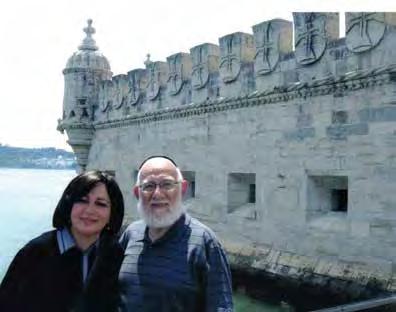
We picked up some vegetables and fruit at a nearby supermarket, heated up our grilled chicken and couscous, and planned for tomorrow while enjoying our dinner. We still managed to take an hour walk before going to sleep. Surprisingly, we were
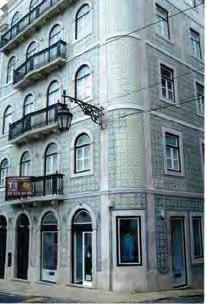
With Yair & Tehilla at the supermarket
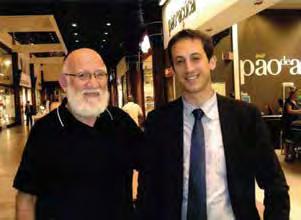
With Rabbi Eliezer DiMartino of the Sharei Tikva Synagogue
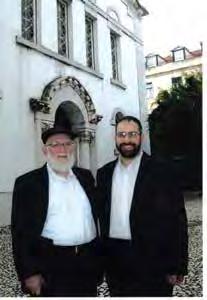
not tired and were up talking until two o’clock in the morning.
On Thursday and during most of Friday, we were on our feet all the time. We toured Castelo St. Jorge, the one-thousand-year-old castle overlooking Lisbon. The tour was extremely informative, and the views were spectacular. We walked around Baixa, the historic heart of the city, and took the funicular up the steep

cobbled streets of Bairro Alto. All the while, we were snapping photos of the colorful porcelain tiled buildings. The sidewalks themselves were paved with geometrically designed Azulejo tiles which is distinct to Lisbon. Yes, they are quite slippery when it rains! We could not help listening to the melancholic Fado songs emanating from the bars and pubs we passed. The charming restaurants advertised their seafood selections on billboards with displays of the ocean’s bounty, most of which were noticeably non-kosher. The many squares dotting the city made for a perfect rest stop where we ate our lunches and watched the hustle and bustle surrounding us. With the exception of Pesi’s wallet being pickpocketed, our experience in Lisbon was fantastico!
On the way back to our hotel on Thursday night, we stopped in the supermarket again. We were shocked to see a young couple, a man with a yarmulke and his wife with a sheitel. They, too, were surprised to meet us. During our introductions, we learned that their names were Yair and Tehilla Freundlich and that he was in charge of security at the Is
With Chabad shluchim Rabbi Eli and Raizel Rosenfeld

raeli embassy. The feeling of meeting other Jews in faraway places always excites us, and it emphasizes how much we really are “one big family.” On Shabbos, we davened at the Sharei Tikva Synagogue where Rabbi Eliezer DiMartino was the rav. The shul was the first one constructed after Jews started to return to Portugal and though the nusach is Portuguese Sephardic, there are Moroccan, Gibraltarian and even Ashkenazic elements during the tefilla. We were invited to eat by Rabbi Eli and Raizel Rosenfeld, the Chabad shluchim in Lisbon. I told the rabbi that his father once gave me a tour of the yeshiva he heads in Pittsburgh. There were a number of other guests that joined for the seudos including Yair and Tehilla Freundlich on Shabbos morning. The atmosphere at the Shabbos table was uplifting, as were the divrei Torah and zemiros. The conversations in a babble of languages were enjoyable, though we obviously did not understand everything. The trek back to the hotel was difficult since the streets of Lisbon were built on sloping hills, and we were going uphill. It did not help that our room was on the eighth floor of the hotel. All in all, it was a beautiful and memorable Shabbos.
Sunday was a lighter day for us. Even so, we saw two major sights. The first was a world class collection of art and furniture at the Gulbenkian Museum. Paintings, sculptures, porcelains, and rugs were some of the outstanding artifacts that the museum displays. We know that not everyone has the same passion as we do about museums of art, but both of us have been exposed to art since childhood and deeply appreciate the creativity and beauty. The second sight we took in on that Sunday was Europe’s largest aquarium. Surprisingly, we were able to spend over two hours observing Hashem’s wonderous creations in the most stunning natural settings. We returned early to our room, ate supper, packed our suitcases, and retired for the night.
We were up at 6 a.m. the next day so that we could check out and leave Lisbon for the two-hour drive to Evora. This small, walled city was once the second most important city in Portugal and has a trove of historic treasures dating back to the Romans and Moors. There was a Jewish presence in Evora since the Middle



Penna National Palace in Sintra


Castella de Mouros in Sintra
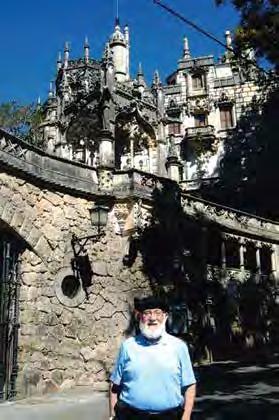
Quinta da Regaleira in Sintra
Ages which was brought to abrupt end with the advent of the Edict of Expulsion and the subsequent Inquisition.
The city is very quaint with its winding alley-like streets, marked by windows with lace curtains and sporting boxes with vibrant flowers. There are plazas with statues and fountains and decorative buildings with architecture dating over many centuries. We walked and rested and walked some more. We saw the Juderia, the former Jewish district and the building that housed the synagogue. We anguished as we were shown the headquarters of the Inquisition, a building where investigations were initiated against our brothers and sisters who secretly maintained their loyalty to the Jewish faith. We also witnessed the courtyard where those hapless souls were torched by the flames of the Auto de Fe. We know that there are no coincidences, yet we were in for a surprise when we went to visit University of Evora. Unbeknown to us, there was an International Conference for Sephardic Studies taking place there with visiting scholars from many countries lecturing on “The encounter of Jews and Moslems on the Iberian Lands.” We were invited to attend and found the drinks as we listened to the soulful strings of the guitar. theme and its lecturers remarkably derstanding of these monumental supply comes from Portugal. We are interesting. We followed the English, stones, although their true purpose both always excited when we see and Hebrew, and German speeches but is still very much debated. He also learn about things that are new to us, were completely tuned out when Porshowed and taught us about the and this day was representative of that type of experience. On the last day of our journey, we went to the town of Sintra on the Portuguese Riviera. This small
We anguished as we were shown the town has an amazing number of fabulous palaces and castles and is the headquarters of the Inquisition, a building wealthiest place in all the land. We where investigations were initiated against visited three of the most famous one castles. The Castella de Mouros, Penour brothers and sisters who secretly na National Palace, and Quinta da Regaleira overwhelmed us, and we maintained their loyalty to the Jewish faith walked away awestruck from their size, beauty, and splendor. Words do not suffice to describe these places, nor do photographs, which we were tuguese or Spanish came into play. vast orchards of cork trees that are going to Sintra was a perfect way of During the warm evening sunset, a great part of the country’s econoending a most enjoyable and fulfillwe sat out in the courtyard sipping my. Fifty percent of the world’s cork ing journey. constantly taking. Suffice it to say,
The next day we took a guide, Hershel Lieber has been involved in kiruv activities for over 30 years. As a founding Mario Olivera, to take us out to see member of the Vaad L’Hatzolas Nidchei Yisroel he has traveled with his wife, Pesi, to the Soviet Union during the harsh years of the Communist regimes to advance Yiddishkeit. the megaliths on the outskirts of He has spearheaded a yeshiva in the city of Kishinev that had 12 successful years with Evora. These ancient stones predate many students making Torah their way of life. In Poland, he lectured in the summers at the well-known Stonehenge site in the Ronald S. Lauder Foundation camp for nearly 30 years. He still travels to Warsaw England. Mario, who is descendant every year – since 1979 – to be the chazzan for Rosh Hashana and Yom Kippur for the Jews of Marranos (as most Marranos there. Together with Pesi, he organized and led trips to Europe on behalf of Gateways and Aish Hatorah for college students finding their paths to Jewish identity. His passion for were given names of fruit trees as travel has taken them to many interesting places and afforded them unique experiences. a method of knowing their Jewish Their open home gave them opportunities to meet and develop relationships with a vabackground), gave us a brief unriety of people. Hershel’s column will appear in The Jewish Home on a bi-weekly basis.










